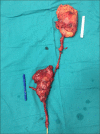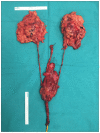Aggressive treatment for urothelial cancer-complete urinary tract extirpation: Operative feasibility in two cases
- PMID: 31509514
- PMCID: PMC6739080
- DOI: 10.5152/tud.2018.55453
Aggressive treatment for urothelial cancer-complete urinary tract extirpation: Operative feasibility in two cases
Abstract
Bladder cancer (BC), the most common malignancy of the urinary tract, accounts for 90-95% of all urothelial carcinomas (UCs), while upper urinary tract UC (UUTUC) accounts for only 5-10%. Radical nephroureterectomy with excision of bladder cuff, and radical cystectomy with pelvic lymph node dissection and a urinary diversion (UD) are the gold standard treatments for UUTUC and muscle-invasive bladder cancer (MIBC), respectively. These two treatments can be performed simultaneously when a bilateral or unilateral UUTUC is present with a MIBC, and are called complete urinary tract extirpation (CUTE) and hemi-CUTE, respectively. This complex surgery can help the patient by avoiding multi-staged surgeries, repeated anesthesia, and delay in completion of treatment. Herein, we report the first cases of a hemi-CUTE and CUTE in our department and share our experience with this aggressive and complex surgical treatment.
Conflict of interest statement
Figures






Similar articles
-
A Robot-Assisted Complete Urinary Tract Extirpation in a Patient with Simultaneous Panurothelial Carcinoma: A Case Report.J Endourol Case Rep. 2020 Dec 29;6(4):483-486. doi: 10.1089/cren.2020.0189. eCollection 2020. J Endourol Case Rep. 2020. PMID: 33457708 Free PMC article.
-
First experience with a new form of orthotopic ileal neobladder (Leuven N-Pouch) following radical cystectomy.Turk J Urol. 2019 Dec 1;45(Supp. 1):S150-S155. doi: 10.5152/tud.2019.68704. Print 2019 Nov. Turk J Urol. 2019. PMID: 32027599 Free PMC article.
-
Treatment Strategy for Dialysis Patient with Urothelial Carcinoma.Diagnostics (Basel). 2021 Oct 22;11(11):1966. doi: 10.3390/diagnostics11111966. Diagnostics (Basel). 2021. PMID: 34829313 Free PMC article.
-
Techniques and Outcomes of Robot-assisted Nephro-ureterectomy for Upper Tract Urothelial Carcinoma.Eur Urol Focus. 2018 Sep;4(5):657-661. doi: 10.1016/j.euf.2018.08.007. Epub 2018 Aug 23. Eur Urol Focus. 2018. PMID: 30146238 Review.
-
Urothelial carcinoma of the bladder and the upper tract: disparate twins.J Urol. 2013 Apr;189(4):1214-21. doi: 10.1016/j.juro.2012.05.079. Epub 2012 Sep 27. J Urol. 2013. PMID: 23023150 Review.
Cited by
-
ASR488, a novel small molecule, activates an mRNA binding protein, CPEB1, and inhibits the growth of bladder cancer.Oncol Lett. 2020 Jul;20(1):850-860. doi: 10.3892/ol.2020.11593. Epub 2020 May 7. Oncol Lett. 2020. PMID: 32566012 Free PMC article.
-
Concurrent radical cystectomy and nephroureterectomy indications and outcomes: a systematic review and comparative analysis.Ther Adv Urol. 2023 May 9;15:17562872231171757. doi: 10.1177/17562872231171757. eCollection 2023 Jan-Dec. Ther Adv Urol. 2023. PMID: 37188157 Free PMC article. Review.
References
LinkOut - more resources
Full Text Sources
